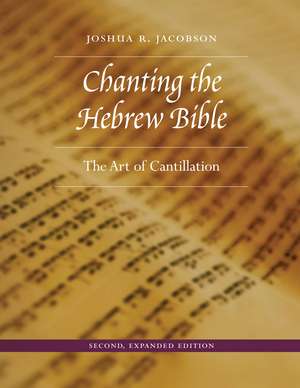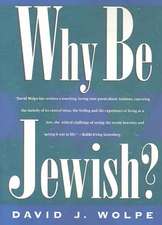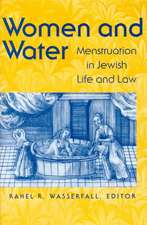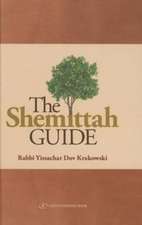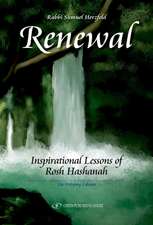Chanting the Hebrew Bible – The Art of Cantillation
Autor Joshua R. Jacobsonen Limba Engleză Hardback – 31 mai 2017
Chanting the Hebrew Bible, Second Edition, will be invaluable to anyone interested in chanting, from beginners to advanced readers—from haftarah readers who want to chant from the Torah, to Bible students seeking greater insight into Masoretic texts, to Torah chanters who wish to fine-tune their skills, fill gaps in their knowledge, and understand the system they have known only intuitively until now.
This second edition features a week-by-week guide to Torah, haftarah, and megillot readings for Shabbat and holidays; useful new examples and exercises; a new comprehensive general subject index; a new, easy-to-read, clear Hebrew font; and a link to a new website with audio recordings and video lessons.
Chanting the Hebrew Bible will continue to be the definitive work on Torah chanting—the most authoritative guide and reference on the subject. For more information on Chanting the Hebrew Bible visit chantingthehebrewbible.com.
Preț: 605.33 lei
Preț vechi: 712.14 lei
-15% Nou
Puncte Express: 908
Preț estimativ în valută:
115.86€ • 120.75$ • 96.45£
115.86€ • 120.75$ • 96.45£
Carte tipărită la comandă
Livrare economică 06-20 ianuarie 25
Preluare comenzi: 021 569.72.76
Specificații
ISBN-13: 9780827612235
ISBN-10: 0827612230
Pagini: 876
Ilustrații: 28 tables, 1503 illustrations, index
Dimensiuni: 223 x 287 x 51 mm
Greutate: 2.29 kg
Ediția:Revizuită
Editura: MQ – University of Nebraska Press
Locul publicării:United States
ISBN-10: 0827612230
Pagini: 876
Ilustrații: 28 tables, 1503 illustrations, index
Dimensiuni: 223 x 287 x 51 mm
Greutate: 2.29 kg
Ediția:Revizuită
Editura: MQ – University of Nebraska Press
Locul publicării:United States
Notă biografică
Joshua R. Jacobson is a professor of music and director of choral activities at Northeastern University, the founder and director of the Zamir Chorale of Boston, and a visiting professor and senior consultant in the School of Jewish Music at Hebrew College. He has guest-conducted and lectured throughout the United States, Europe, Israel, and Australia. Jacobson is the coauthor of Translations and Annotations of Choral Repertoire, vol. 4: Hebrew Texts.
Cuprins
How to Use this Book
Transliterations, Translations and Text Sources
Chapter 1 Cantillation
The Ritual Art of Chanting the Hebrew Scriptures
The Terminology of Cantillation
Chironomy
Why Chant?
The Scroll
Ambiguity in the Consonantal Text
The Masoretic Text
The Rhythm of Cantillation
The Pitches of Cantillation
Ekphonetic Notation
Transcriptions of the te‘amim
Inflection
Resolving Ambiguity
Chapter 2.1 Parallelism
Corresponding Parallelism
Parallel Actions
Analogous Parallelism
Elliptical Parallelism
Chapter 2.2 The Primary Dichotomy: Siluk and Etnaḥta
The Disjunctive Siluk
Meteg
The Disjunctive Etnaḥta
Chanting
Diagramming Phrases
Parsing
Level One: Contiguous Segments
Exception: Verses without Etnaḥta
The Pausal Form
Word Order
Chapter 2.3 Level Two: Tippeḥa
The Secondary Dichotomy: Tippeḥa
Three Independent Clauses
The Simple Sentence
The Nominal Clause
Chapter 2.4 Conjunctives
Recursive Dichotomy
Disjunctives and Conjunctives within a Segment
Merekha – The “Servant” of Siluk
Merekha – The “Servant” of Tippeḥa
Merekha Khefulah
Munaḥ
Conjunctives and Dagesh Kal
The “Conjunctive Soft” Form
Chapter 2.5 Substitutions
Tippeḥa Substituting for a Conjunctive
One-Word Clauses in Level One
Two Te‘amim on a Long Word
Mayela and Siluk on a Single Word
Mayela and Etnaḥta on a Single Word
Munaḥ and Etnaḥta on a Single Word
Merekha and Tippeḥa on a Single Word
Two Munaḥs: A Double Conjunctive
Chapter 2.6 Level Two: Zakef
Stepping Segments
Stepping Segments and Nesting Segments
The Four Forms of Zakef
Munaḥ—The Conjunctive Serving Zakef Katon
A New Model
Another Upgrade
Review: Three Models of Dichotomy
Review
Verb in Second Position
The Word לֵאמרֹ
The Vocative Case
Chapter 2.7 Level Two: Segol
When Does Segol Appear?
Munaḥ—The Conjunctive Serving Segol.
Shalshelet as a Substitute for Segol
Pasek
The Seven Occurences of Shalshelet
Rabbinic Exegesis of Shalshelet
Chapter 2.8 Tevir
The Disjunctive Tevir
Examples of Tevir
Relative Cadences: Tippeḥa and Tevir
Upgrading: Tevir Substituting for Merekha
The Conjunctives of Tevir: Darga and Merekha
A New Model
Verb In Terminal Position
Chapter 2.9 The Remote Conjunctives of Tevir
Kadma And Munaḥ: The Secondary Conjunctives of Tevir
Verb in the Middle — Part Two
Secondary Accents
Merekha Khefulah and Darga: Two Conjunctives before Tippeḥa
More than One Remote Conjunctive
Three or More Conjunctives
Chapter 2.10 Revia‘
Upgrade: Tevir to Revia‘
The Dichotomy of Lists
Revia‘ Analysis
Three Level-Three “Stepping” Segments
Darga—The Remote Conjunctive Of Revia‘
Three Conjunctives before Revia‘
Chapter 2.11 Pashta
The Disjunctive Pashta
Pashta and Kadma
Yetiv—A Substitute for Pashta
Munaḥ Upgraded to Pashta or Yetiv
The Meteg as Lengthener
Substitutions and the Conjunctive-Rafeh Rule
Verses with No Conjunctives
The Conjunctives of Pashta—Mahpakh and Merekha
Derivation of the Name “Mahpakh”
Mahpakh and Pashta on The Same Word
Mahpakh and Yetiv
The Retracted Accent—Nasog Aḥor
The Remote Conjunctives of Pashta—Kadma or Munaḥ
The Third and Fourth Remote Conjunctives of Pashta
Revia‘—The Initial Level-Three Disjunctive before Pashta
Upgrading Pashta to Revia‘
Chapter 2.12 Zarka
Zarka
The Conjunctives of Zarka
Upgrading Munaḥ-Segol to Zarka-Segol
Upgrading for Long Words
The Remote Conjunctives of Zarka—Kadma or Munaḥ
Munaḥ Instead of Kadma
Three Conjunctives before Zarka
Four Conjunctives before Zarka
Two Subdivisions under Segol
Three Subdivisions under Segol
Chapter 2.13 Level Four: Geresh
Simple Verses and Complex Verses
Subdividing a Level-Three Segment
Geresh and Double Geresh
The Forms of Geresh
Geresh without a Conjunctive
Upgrading for Long Words
The Conjunctives of Geresh—Kadma and Munaḥ
The Remote Conjunctive of Geresh—Telishah Ketanah
Munaḥ—The Conjunctive before Telishah Ketanah
To Geresh or Not to Geresh?
The Geresh Segment In Context
Chapter 2.14 Level Four: Legarmeh
The Disjunctive Legarmeh
Legarmeh or Geresh?
The 2+1 Division and Exceptions to the Rule
Stepping Level-Four Segments
The Conjunctive of Legarmeh—Merekha
Three or More Stepping Segments
Analysis of Complete Verses
Chapter 2.15 Level Four: Pazer
The Distribution of Level-Four Terminators
The Disjunctive Pazer (Katan)
The Conjunctive of Pazer—Munaḥ
Level-Four Segments
Three Stepping Segments
The Pazer Segment in Context
Lists
Level Five
Chapter 2.16 Level Four: Pazer Gadol
The Disjunctive Pazer Gadol (Karney-Farah)
The Conjunctive of Pazer Gadol—Galgal (Yeraḥ-Ben-Yomo)
The Pazer Gadol Clause in Context
Chapter 2.17 Telishah Gedolah
The Disjunctive Telishah Gedolah
Telishah Gedolah as a Substitute for Geresh
Telishah Gedolah and Geresh on the Same Word
Telishah Gedolah as a Substitute for Pazer
Telishah Gedolah as a Level-Five Terminator
Telishah Gedolah as a Substitute for Telishah Ketanah
The Telishah Gedolah Clause in Context
Chapter 3 Pronunciation
The Importance of Correct Pronunciation
Halakhic Evidence
The Evolution of the Hebrew Language
An Official Hebrew Diction
The “Elevated” Style
About this Guide
Consonant “Voicing”
The Pronunciation of א
The Pronunciation of כ and ח
The Pronunciation of ר
Other Differences
Run-on Words
Vowel Length
Pure Vowels
Consistent Pronunciation
Doubled Consonants
Becoming Familiar with Dagesh Ḥazak
Mappik
The Function of Mappik
The Sound of Mappik
Shin and Sin
Matres Lectionis— אִמּוֺת הַקְּרִיאָה
Syllables
Open Syllables
Closed Syllables
Dagesh Kal
The Conjunctive Soft Form
Consonant Endings
כ Dagesh Ḥazak in בּ גּ דּ פּ תּ
Vocal Sheva (Sheva Na‘)
Intermediate Sheva (Sheva Meraḥef)
Summary: Prefix Chart
Kamats Forms
Kamats before Deḥik
Two Approaches to the Rules of Pronunciation
Furtive Pataḥ (Pataḥ Genuvah)
וּ וֹ And as Consonants
Some Words Are Not Pronounced as They Are Written
Syllabic Stress: Millera‘ and Mille‘el
Marking the Accent
The Secondary Accent
Syllabic Rhythm
Makkef
Vowel Length Reduction in Connected Words
Special Te‘amim for Contiguous Accents
Retraction נָסוֹג אֲחוֹר
Secondary Stress
Observations on Secondary Stress
The Euphonic Meteg מֶֽתֶג לְתִיקוּן הַקְּרִיאָה
Meteg Summary
The Pausal Form צוּרַת הַהֶפְסֵק
Vowel Changes in Pausal Form
Change Of Stress in the Hiatus Form
Change Of Stress in Vav Conversive
The Directional (or “Locative”) Suffix ה׳ הַמְּגַמָּה
Suffixes and Syllabic Stress
Rare Words that Begin with Dagesh Ḥazak ( דְּחיִק )
Pronunciation of the Conjunctive Dagesh
The Vocalization of Prefixes
The Definite Article ה׳ הַיְדִיעָה
כ Prepositional Prefixes בַּ לַ
The Word מה
The Interrogative Prefix ה׳ הַשְּׁאֵלָה
Vav Conjunctive ו׳ הַחִבּוּר
Vav Conversive ו׳ הַהִפּוּךְ
The Prepositional Prefixes ב כ ל
The Prepositional Prefix מ
Formal Classical Pronunciation versus Colloquial Modern Pronunciation
General Pronunciation Exercises
Chapter 4 Canon And Masorah
A History of the Scrolls
The Aniquity of Cantillation
Where Do the Melodies Come From?
The Chanting of Scripture
Did Tiberian Notation Represent an Ancient Tradition?
The Septuagint
Other Ancient Greek Manuscripts
Evidence in the Talmud
Other Systems of Punctuation
The Musical Realization of the Tiberian System
The Notation Systems
The Tiberian Codices
The Aleppo Codex
Other Ancient Codices
Chapter and Verse
Printed Bibles
The Soferim and the Consonantal Text
Masoretic Annotations and Lists
Chapter 5.1 The Te‘amim
Disjunctives
Conjunctives
Other Signs
Remote Conjunctives
Invariables
Upgrading in a Two-Word Domain
Upgrading in the Presence of Long Words
Substitutions for Musical Considerations
Frequency Chart
Repeating Te‘amim
The Hierarchy of the Te‛amim
The Twenty-One Books and the Three Books
The Poetic Books: Psalms, Proverbs and Job
Chapter 5.2 Two Te‘amim on a Single Word
Primary and Secondary Accents
Meteg
The Euphonic Meteg
Double Conjunctives
Double Disjunctives
Doubled Invariables
Postpositives
Prepositives
High and Low Accents: Two Traditions
The Decalogue
The Saga Of Reuben
Chapter 5.3 Troubleshooting
Commonly Confused Te‘amim
Errors in Rhythm
Commonly Mispronounced Consonants
Commonly Mispronounced Vowels
Incorrect Syllabic Stress
Biblical Hebrew and Contemporary Hebrew
The Last Word
Chapter 5.4 Parsing The Hebrew Bible
Some Definitions
Overview—The Steps Involved in Parsing
Identify the Verbs
Parallelism—Pairs of Clauses
The Verbless (Nominal) Clause
Coordinated Verbs
More than Two Independent Clauses
The Subordinate Clause
Downgrading the Time Stamp
Inverted Downgrade
Quotations
Linked Word Pairs
Inconsistency of Style
Construct ( סְמִיכוּת ) Followed by a Linked Pair
Particles
Other Words
The Word לֵאמרֹ
Lists
Emphatic Words
The Verb and its Complements
Puzzling Punctuation
The Limits of Predictability
Chapter 5.5 The Pedagogy of Cantillation
The Cantillation Class
Applying the Paradigm to the Student’s Portion
Flash Cards
Dictation
Listening Activities
Teaching Inflection
Applying the Melodies to Familiar Words
Reinforcing the Patterns
Suggestions for Self-Study
Preparing to Read from a Scroll
Chapter 6.1 Interpreting the Te‘amim
Music of the People
The Liquid Tradition Becomes Frozen
One Tradition among Many
Music Serves the Text
Transcription of the Te‘amim
Rhythmic Notation
Pitch Notation
The Names of the Te‘amim
Syllabic Stress
Improvisation
Smoothing
Redistribution
Compensation
Pick-Up Pitch Adjustment
The Rhythm of Cantillation
Reading Complete Phrases
High and Low Te‘amim
Chapter 6.2 Torah
Historical Development of the Public Reading
Contemporary Practices in Traditional Synagogues
The Cycle of Readings
The Combined Pericope פרשה מחוברת
The Division of the Pericope
Extra Aliyot
The Number of Olim
The Number of Verses
The Maftir
Simḥat Torah Customs
Procedures Related to the Torah Reading
The Correct Reading of the Torah
Qualifications for the Ba‘al Keri’ah
Correcting An Error In The Reading
A Defect in the Scroll
Tokheḥot
Remembering Amalek
Ta‘amey Ha-‘Elyon
Other Special Customs
The Melodies of the Cantillation Motifs
The Siluk and Etnaḥta Segments
The Zakef Segment
The Tevir Segment
The Pashta/Yetiv Segment
The Segol/Shalshelet Segment
The Revia‘ Segment
The Legarmeh Segment
The Geresh Segment
Telishah Gedolah
Pazer
Munaḥ Galgal Pazer-Gadol
The Final Cadence
Special Melodies
Akdamut Millin
Chanting the Torah Blessings
The Kaddish
Summary of the Te‘amim
The Scale of the Torah Cantillation
The Te‘amim according to Abraham Binder
Chapter 6.3 Haftarah
Contemporary Traditional Practice
Historical Development of the Haftarah
Customs
Etymology
Haftarah Chart
The Melodies of the Cantillation Motifs
The Siluk and Etnaḥta Segments
The Zakef Segment
The Tevir Segment
The Pashta/Yetiv Segment
The Segol Segment
The Revia‘ Segment
The Legarmeh Segment
The Geresh Segment
Other Segments
The Final Cadence
Modulations to the Lamentation Mode
Blessings
Yatsiv Pitgam
Summary of the Te‘amim
Chapter 6.4 The Festival Megillot: Song Of Songs, Ruth, and Ecclesiastes
The Contemporary Practicea nd its Roots
The Song of Songs
Ruth
Ecclesiastes
The Siluk and Etnaḥta Segments
Merekha Siluk
Etnaḥta
Tippeḥa
The Tevir Segment
The Zakef Segment
The Pashta/Yetiv Segment
The Segol Segment
The Revia‘ Segment
The Legarmeh Segment
The Geresh Segment
Gereshayim
Telishah Gedolah
Pazer
The Final Cadence
Blessings
Summary of the Te‘amim
Chapter 6.5 Esther
The Contemporary Practice and its Roots
The Siluk and Etnaḥta Segments
Tippeḥa
The Tevir Segment
The Zakef Segment
The Pashta/Yetiv Segment
The Segol Segment
The Revia‘ Segment
The Legarmeh Segment
The Geresh Segment
Telishah Gedolah
Pazer
Munaḥ Galgal Pazer-Gadol
The Final Cadence
The Invitational Cadence
Lamentation Verses
Exceptional Verses
Blessings
Shoshannat Ya‘akov
Summary of the Te’amim
The Scale of the Te‘amim
The Axes of the Te‘amim
Chapter 6.6 Lamentations (Ekhah)
Structure
Liturgical Use
Lamentations Motifs in other Readings
Chanting Chapter Three
The Siluk and Etnaḥta Segments
Tippeḥa
The Tevir Segment
The Zakef Segment
The Pashta/Yetiv Segment
The Segol Segment
The Revia‘ Segment
The Legarmeh Segment
The Geresh Segment
Other
Final Cadences
Summary of the Te‘amim
The Scale of the Cantillation
Chapter 6.7 Torah for the High Holiday Morning Service
The Siluk and Etnaḥta Segments
Tippeḥa
The Tevir Segment
The Zakef Segment
The Pashta/Yetiv Segment
The Segol Segment
The Revia‘ Segment
The Legarmeh Segment
The Geresh Segment
Telishah Gedolah
Pazer
The Final Cadence
Chanting the Blessings
Kaddish
Summary of the Te‘amim
The Scale of the Te‘amim
Chapter 7.1 Comparison Chart
Chapter 7.2 The Ideal Reader
Chapter 7.3 Guide to the Readings
Genesis
Exodus
Leviticus
Numbers
Deuteronomy
Special Torah Readings
Simḥat Torah
Public Fast Days
Rosh Ḥodesh
Shavuot
High Holidays
Haftarot
Genesis — Haftarot
Exodus — Haftarot
Leviticus — Haftarot
Numbers — Haftarot
Deuteronomy — Haftarot
Special Haftarot
Ruth
Song of Songs
Ecclesiastes (Kohelet)
Lamentations
Esther
Chapter 7.4 Glossary
Bibliography
Index
Transliterations, Translations and Text Sources
Chapter 1 Cantillation
The Ritual Art of Chanting the Hebrew Scriptures
The Terminology of Cantillation
Chironomy
Why Chant?
The Scroll
Ambiguity in the Consonantal Text
The Masoretic Text
The Rhythm of Cantillation
The Pitches of Cantillation
Ekphonetic Notation
Transcriptions of the te‘amim
Inflection
Resolving Ambiguity
Chapter 2.1 Parallelism
Corresponding Parallelism
Parallel Actions
Analogous Parallelism
Elliptical Parallelism
Chapter 2.2 The Primary Dichotomy: Siluk and Etnaḥta
The Disjunctive Siluk
Meteg
The Disjunctive Etnaḥta
Chanting
Diagramming Phrases
Parsing
Level One: Contiguous Segments
Exception: Verses without Etnaḥta
The Pausal Form
Word Order
Chapter 2.3 Level Two: Tippeḥa
The Secondary Dichotomy: Tippeḥa
Three Independent Clauses
The Simple Sentence
The Nominal Clause
Chapter 2.4 Conjunctives
Recursive Dichotomy
Disjunctives and Conjunctives within a Segment
Merekha – The “Servant” of Siluk
Merekha – The “Servant” of Tippeḥa
Merekha Khefulah
Munaḥ
Conjunctives and Dagesh Kal
The “Conjunctive Soft” Form
Chapter 2.5 Substitutions
Tippeḥa Substituting for a Conjunctive
One-Word Clauses in Level One
Two Te‘amim on a Long Word
Mayela and Siluk on a Single Word
Mayela and Etnaḥta on a Single Word
Munaḥ and Etnaḥta on a Single Word
Merekha and Tippeḥa on a Single Word
Two Munaḥs: A Double Conjunctive
Chapter 2.6 Level Two: Zakef
Stepping Segments
Stepping Segments and Nesting Segments
The Four Forms of Zakef
Munaḥ—The Conjunctive Serving Zakef Katon
A New Model
Another Upgrade
Review: Three Models of Dichotomy
Review
Verb in Second Position
The Word לֵאמרֹ
The Vocative Case
Chapter 2.7 Level Two: Segol
When Does Segol Appear?
Munaḥ—The Conjunctive Serving Segol.
Shalshelet as a Substitute for Segol
Pasek
The Seven Occurences of Shalshelet
Rabbinic Exegesis of Shalshelet
Chapter 2.8 Tevir
The Disjunctive Tevir
Examples of Tevir
Relative Cadences: Tippeḥa and Tevir
Upgrading: Tevir Substituting for Merekha
The Conjunctives of Tevir: Darga and Merekha
A New Model
Verb In Terminal Position
Chapter 2.9 The Remote Conjunctives of Tevir
Kadma And Munaḥ: The Secondary Conjunctives of Tevir
Verb in the Middle — Part Two
Secondary Accents
Merekha Khefulah and Darga: Two Conjunctives before Tippeḥa
More than One Remote Conjunctive
Three or More Conjunctives
Chapter 2.10 Revia‘
Upgrade: Tevir to Revia‘
The Dichotomy of Lists
Revia‘ Analysis
Three Level-Three “Stepping” Segments
Darga—The Remote Conjunctive Of Revia‘
Three Conjunctives before Revia‘
Chapter 2.11 Pashta
The Disjunctive Pashta
Pashta and Kadma
Yetiv—A Substitute for Pashta
Munaḥ Upgraded to Pashta or Yetiv
The Meteg as Lengthener
Substitutions and the Conjunctive-Rafeh Rule
Verses with No Conjunctives
The Conjunctives of Pashta—Mahpakh and Merekha
Derivation of the Name “Mahpakh”
Mahpakh and Pashta on The Same Word
Mahpakh and Yetiv
The Retracted Accent—Nasog Aḥor
The Remote Conjunctives of Pashta—Kadma or Munaḥ
The Third and Fourth Remote Conjunctives of Pashta
Revia‘—The Initial Level-Three Disjunctive before Pashta
Upgrading Pashta to Revia‘
Chapter 2.12 Zarka
Zarka
The Conjunctives of Zarka
Upgrading Munaḥ-Segol to Zarka-Segol
Upgrading for Long Words
The Remote Conjunctives of Zarka—Kadma or Munaḥ
Munaḥ Instead of Kadma
Three Conjunctives before Zarka
Four Conjunctives before Zarka
Two Subdivisions under Segol
Three Subdivisions under Segol
Chapter 2.13 Level Four: Geresh
Simple Verses and Complex Verses
Subdividing a Level-Three Segment
Geresh and Double Geresh
The Forms of Geresh
Geresh without a Conjunctive
Upgrading for Long Words
The Conjunctives of Geresh—Kadma and Munaḥ
The Remote Conjunctive of Geresh—Telishah Ketanah
Munaḥ—The Conjunctive before Telishah Ketanah
To Geresh or Not to Geresh?
The Geresh Segment In Context
Chapter 2.14 Level Four: Legarmeh
The Disjunctive Legarmeh
Legarmeh or Geresh?
The 2+1 Division and Exceptions to the Rule
Stepping Level-Four Segments
The Conjunctive of Legarmeh—Merekha
Three or More Stepping Segments
Analysis of Complete Verses
Chapter 2.15 Level Four: Pazer
The Distribution of Level-Four Terminators
The Disjunctive Pazer (Katan)
The Conjunctive of Pazer—Munaḥ
Level-Four Segments
Three Stepping Segments
The Pazer Segment in Context
Lists
Level Five
Chapter 2.16 Level Four: Pazer Gadol
The Disjunctive Pazer Gadol (Karney-Farah)
The Conjunctive of Pazer Gadol—Galgal (Yeraḥ-Ben-Yomo)
The Pazer Gadol Clause in Context
Chapter 2.17 Telishah Gedolah
The Disjunctive Telishah Gedolah
Telishah Gedolah as a Substitute for Geresh
Telishah Gedolah and Geresh on the Same Word
Telishah Gedolah as a Substitute for Pazer
Telishah Gedolah as a Level-Five Terminator
Telishah Gedolah as a Substitute for Telishah Ketanah
The Telishah Gedolah Clause in Context
Chapter 3 Pronunciation
The Importance of Correct Pronunciation
Halakhic Evidence
The Evolution of the Hebrew Language
An Official Hebrew Diction
The “Elevated” Style
About this Guide
Consonant “Voicing”
The Pronunciation of א
The Pronunciation of כ and ח
The Pronunciation of ר
Other Differences
Run-on Words
Vowel Length
Pure Vowels
Consistent Pronunciation
Doubled Consonants
Becoming Familiar with Dagesh Ḥazak
Mappik
The Function of Mappik
The Sound of Mappik
Shin and Sin
Matres Lectionis— אִמּוֺת הַקְּרִיאָה
Syllables
Open Syllables
Closed Syllables
Dagesh Kal
The Conjunctive Soft Form
Consonant Endings
כ Dagesh Ḥazak in בּ גּ דּ פּ תּ
Vocal Sheva (Sheva Na‘)
Intermediate Sheva (Sheva Meraḥef)
Summary: Prefix Chart
Kamats Forms
Kamats before Deḥik
Two Approaches to the Rules of Pronunciation
Furtive Pataḥ (Pataḥ Genuvah)
וּ וֹ And as Consonants
Some Words Are Not Pronounced as They Are Written
Syllabic Stress: Millera‘ and Mille‘el
Marking the Accent
The Secondary Accent
Syllabic Rhythm
Makkef
Vowel Length Reduction in Connected Words
Special Te‘amim for Contiguous Accents
Retraction נָסוֹג אֲחוֹר
Secondary Stress
Observations on Secondary Stress
The Euphonic Meteg מֶֽתֶג לְתִיקוּן הַקְּרִיאָה
Meteg Summary
The Pausal Form צוּרַת הַהֶפְסֵק
Vowel Changes in Pausal Form
Change Of Stress in the Hiatus Form
Change Of Stress in Vav Conversive
The Directional (or “Locative”) Suffix ה׳ הַמְּגַמָּה
Suffixes and Syllabic Stress
Rare Words that Begin with Dagesh Ḥazak ( דְּחיִק )
Pronunciation of the Conjunctive Dagesh
The Vocalization of Prefixes
The Definite Article ה׳ הַיְדִיעָה
כ Prepositional Prefixes בַּ לַ
The Word מה
The Interrogative Prefix ה׳ הַשְּׁאֵלָה
Vav Conjunctive ו׳ הַחִבּוּר
Vav Conversive ו׳ הַהִפּוּךְ
The Prepositional Prefixes ב כ ל
The Prepositional Prefix מ
Formal Classical Pronunciation versus Colloquial Modern Pronunciation
General Pronunciation Exercises
Chapter 4 Canon And Masorah
A History of the Scrolls
The Aniquity of Cantillation
Where Do the Melodies Come From?
The Chanting of Scripture
Did Tiberian Notation Represent an Ancient Tradition?
The Septuagint
Other Ancient Greek Manuscripts
Evidence in the Talmud
Other Systems of Punctuation
The Musical Realization of the Tiberian System
The Notation Systems
The Tiberian Codices
The Aleppo Codex
Other Ancient Codices
Chapter and Verse
Printed Bibles
The Soferim and the Consonantal Text
Masoretic Annotations and Lists
Chapter 5.1 The Te‘amim
Disjunctives
Conjunctives
Other Signs
Remote Conjunctives
Invariables
Upgrading in a Two-Word Domain
Upgrading in the Presence of Long Words
Substitutions for Musical Considerations
Frequency Chart
Repeating Te‘amim
The Hierarchy of the Te‛amim
The Twenty-One Books and the Three Books
The Poetic Books: Psalms, Proverbs and Job
Chapter 5.2 Two Te‘amim on a Single Word
Primary and Secondary Accents
Meteg
The Euphonic Meteg
Double Conjunctives
Double Disjunctives
Doubled Invariables
Postpositives
Prepositives
High and Low Accents: Two Traditions
The Decalogue
The Saga Of Reuben
Chapter 5.3 Troubleshooting
Commonly Confused Te‘amim
Errors in Rhythm
Commonly Mispronounced Consonants
Commonly Mispronounced Vowels
Incorrect Syllabic Stress
Biblical Hebrew and Contemporary Hebrew
The Last Word
Chapter 5.4 Parsing The Hebrew Bible
Some Definitions
Overview—The Steps Involved in Parsing
Identify the Verbs
Parallelism—Pairs of Clauses
The Verbless (Nominal) Clause
Coordinated Verbs
More than Two Independent Clauses
The Subordinate Clause
Downgrading the Time Stamp
Inverted Downgrade
Quotations
Linked Word Pairs
Inconsistency of Style
Construct ( סְמִיכוּת ) Followed by a Linked Pair
Particles
Other Words
The Word לֵאמרֹ
Lists
Emphatic Words
The Verb and its Complements
Puzzling Punctuation
The Limits of Predictability
Chapter 5.5 The Pedagogy of Cantillation
The Cantillation Class
Applying the Paradigm to the Student’s Portion
Flash Cards
Dictation
Listening Activities
Teaching Inflection
Applying the Melodies to Familiar Words
Reinforcing the Patterns
Suggestions for Self-Study
Preparing to Read from a Scroll
Chapter 6.1 Interpreting the Te‘amim
Music of the People
The Liquid Tradition Becomes Frozen
One Tradition among Many
Music Serves the Text
Transcription of the Te‘amim
Rhythmic Notation
Pitch Notation
The Names of the Te‘amim
Syllabic Stress
Improvisation
Smoothing
Redistribution
Compensation
Pick-Up Pitch Adjustment
The Rhythm of Cantillation
Reading Complete Phrases
High and Low Te‘amim
Chapter 6.2 Torah
Historical Development of the Public Reading
Contemporary Practices in Traditional Synagogues
The Cycle of Readings
The Combined Pericope פרשה מחוברת
The Division of the Pericope
Extra Aliyot
The Number of Olim
The Number of Verses
The Maftir
Simḥat Torah Customs
Procedures Related to the Torah Reading
The Correct Reading of the Torah
Qualifications for the Ba‘al Keri’ah
Correcting An Error In The Reading
A Defect in the Scroll
Tokheḥot
Remembering Amalek
Ta‘amey Ha-‘Elyon
Other Special Customs
The Melodies of the Cantillation Motifs
The Siluk and Etnaḥta Segments
The Zakef Segment
The Tevir Segment
The Pashta/Yetiv Segment
The Segol/Shalshelet Segment
The Revia‘ Segment
The Legarmeh Segment
The Geresh Segment
Telishah Gedolah
Pazer
Munaḥ Galgal Pazer-Gadol
The Final Cadence
Special Melodies
Akdamut Millin
Chanting the Torah Blessings
The Kaddish
Summary of the Te‘amim
The Scale of the Torah Cantillation
The Te‘amim according to Abraham Binder
Chapter 6.3 Haftarah
Contemporary Traditional Practice
Historical Development of the Haftarah
Customs
Etymology
Haftarah Chart
The Melodies of the Cantillation Motifs
The Siluk and Etnaḥta Segments
The Zakef Segment
The Tevir Segment
The Pashta/Yetiv Segment
The Segol Segment
The Revia‘ Segment
The Legarmeh Segment
The Geresh Segment
Other Segments
The Final Cadence
Modulations to the Lamentation Mode
Blessings
Yatsiv Pitgam
Summary of the Te‘amim
Chapter 6.4 The Festival Megillot: Song Of Songs, Ruth, and Ecclesiastes
The Contemporary Practicea nd its Roots
The Song of Songs
Ruth
Ecclesiastes
The Siluk and Etnaḥta Segments
Merekha Siluk
Etnaḥta
Tippeḥa
The Tevir Segment
The Zakef Segment
The Pashta/Yetiv Segment
The Segol Segment
The Revia‘ Segment
The Legarmeh Segment
The Geresh Segment
Gereshayim
Telishah Gedolah
Pazer
The Final Cadence
Blessings
Summary of the Te‘amim
Chapter 6.5 Esther
The Contemporary Practice and its Roots
The Siluk and Etnaḥta Segments
Tippeḥa
The Tevir Segment
The Zakef Segment
The Pashta/Yetiv Segment
The Segol Segment
The Revia‘ Segment
The Legarmeh Segment
The Geresh Segment
Telishah Gedolah
Pazer
Munaḥ Galgal Pazer-Gadol
The Final Cadence
The Invitational Cadence
Lamentation Verses
Exceptional Verses
Blessings
Shoshannat Ya‘akov
Summary of the Te’amim
The Scale of the Te‘amim
The Axes of the Te‘amim
Chapter 6.6 Lamentations (Ekhah)
Structure
Liturgical Use
Lamentations Motifs in other Readings
Chanting Chapter Three
The Siluk and Etnaḥta Segments
Tippeḥa
The Tevir Segment
The Zakef Segment
The Pashta/Yetiv Segment
The Segol Segment
The Revia‘ Segment
The Legarmeh Segment
The Geresh Segment
Other
Final Cadences
Summary of the Te‘amim
The Scale of the Cantillation
Chapter 6.7 Torah for the High Holiday Morning Service
The Siluk and Etnaḥta Segments
Tippeḥa
The Tevir Segment
The Zakef Segment
The Pashta/Yetiv Segment
The Segol Segment
The Revia‘ Segment
The Legarmeh Segment
The Geresh Segment
Telishah Gedolah
Pazer
The Final Cadence
Chanting the Blessings
Kaddish
Summary of the Te‘amim
The Scale of the Te‘amim
Chapter 7.1 Comparison Chart
Chapter 7.2 The Ideal Reader
Chapter 7.3 Guide to the Readings
Genesis
Exodus
Leviticus
Numbers
Deuteronomy
Special Torah Readings
Simḥat Torah
Public Fast Days
Rosh Ḥodesh
Shavuot
High Holidays
Haftarot
Genesis — Haftarot
Exodus — Haftarot
Leviticus — Haftarot
Numbers — Haftarot
Deuteronomy — Haftarot
Special Haftarot
Ruth
Song of Songs
Ecclesiastes (Kohelet)
Lamentations
Esther
Chapter 7.4 Glossary
Bibliography
Index
Recenzii
"The improvements and additions to the text, the new Index and enlarged Bibliography, the clear fonts and visual presentation, and the added charts make this book a 'must-have' for the regular use of everyone who chants and teaches trop."—Neil Schwartz, Journal of Synagogue Music
“Jacobson has delivered an indispensable teaching tool that, quite unusually, is a genuinely fascinating read. . . . Even those who consider themselves experts will learn a lot from this book. . . . Jacobson consistently provides a wealth of interesting historical material to make this a great reference book.”—Susan Miron, The Forward
“An authoritative, exhaustively detailed survey of the history, structure, performance, and inculcation of the trope.”—Stuart Schoffman, Jerusalem Report
“Monumental in scope and richly detailed, this revised edition of Chanting the Hebrew Bible—enriched by a week-by-week guide to the Torah, haftarah, and megillot readings, and a comprehensive index—is an invaluable contribution to the study and practice of biblical cantillation. Jacobson’s work of impressive scholarship is simultaneously an accessible and engaging practical resource.”—Rabbi Jeffrey A. Summit, author of Singing God’s Words: The Performance of Biblical Chant in Contemporary Judaism
“This encyclopedic volume is a ‘must-have’ for all serious students of cantillation—and for anyone who wants to learn how to chant Hebrew texts and understand the whys of the cantillation systems.”—Nancy Abramson, cantor and director of the H. L. Miller Cantorial School at Jewish Theological Seminary
“The cantillation of Hebrew scripture is an indispensable portal to its authentic interpretation, and Jacobson has extraordinary command of this material. Students and scholars, beginners and experts—everyone who treasures this foundational form of biblical learning has much cause for celebration.”—Richard Cohn, cantor and director of the Debbie Friedman School of Sacred Music, Hebrew Union College–Jewish Institute of Religion
